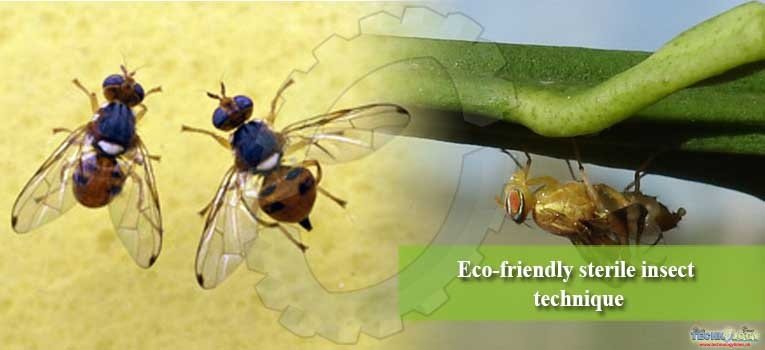The sterile insect technique is a control method for insects. This method is better than insecticidal spray because it is environmentally-friendly.
 Insect pest control method involving the mass-rearing and sterilization, using radiation, of a target pest, followed by the systematic area-wide release of the sterile males by air over defined areas, where they mate with wild females resulting in no offspring and a declining pest population.
Insect pest control method involving the mass-rearing and sterilization, using radiation, of a target pest, followed by the systematic area-wide release of the sterile males by air over defined areas, where they mate with wild females resulting in no offspring and a declining pest population.
The sterile insect technique, or SIT for short, is among the most environment-friendly insect pest control methods ever developed. Irradiation, such as with gamma rays and X-rays, is used to sterilize mass-reared insects so that, while they remain sexually competitive, they cannot produce offspring. SIT does not involve transgenic (genetic engineering) processes.
The International plant protection categorizes sterile insects as beneficial organisms. The SIT differs from classical biological control, which involves the introduction of non-native biological control agents, in several ways:
- Sterile insects are not self-replicating and therefore cannot become established in the environment.
- Breaking the pest’s reproductive cycle, also called autocidal control, is by definition species-specific.
- The SIT does not introduce non-native species into an ecosystem.
Benefits of the technique
The sterile insect technique was first developed in the USA and has been used successfully for more than 60 years. It is currently applied on six continents.
The four strategic options in which sterile insects are being deployed as a component of area-wide integrated pest management are: suppression, eradication, containment and prevention.
For over five decades the SIT has been a major subject of the joint FAO/IAEA programme on Nuclear Techniques in Food and Agriculture. It involves both applied research to improve the technique and develop it for new pest insects;
And the transfer of the SIT package to Member States through field projects so that these can benefit from improved plant, animal and human health; cleaner environments; increased crop and animal production in agricultural systems; and accelerated economic development.
Integrated with other control methods, the SIT has been successful in controlling a number of high-profile insect pests, including fruit flies (Mediterranean fruit fly, Mexican fruit fly, oriental fruit fly, melon fly); tsetse fly; screw worm; moths (codling moth, pink bollworm, false codling moth, cactus moth, and the Australian painted apple moth); and mosquitoes.
In several countries where the technology has been applied, retrospective economic assessment studies have shown a very high return on investment.
Benefits of using the technology include: a significant reduction in crop and livestock production losses; protection of the horticultural and livestock industries through prevention of pest introductions;
Providing conditions for commodity exports to high value markets without quarantine restrictions; protecting and creating jobs; significant reduction in production and human health costs; and environmental protection through a reduced use of insecticides.
Authors: Muhammad Shafi Hasni, Muhammad Kasib Khan
- Department of Parasitology, University of Agriculture Faisalabad-Pakistan
*Corresponding author email: shafi.hasni@gmail.com